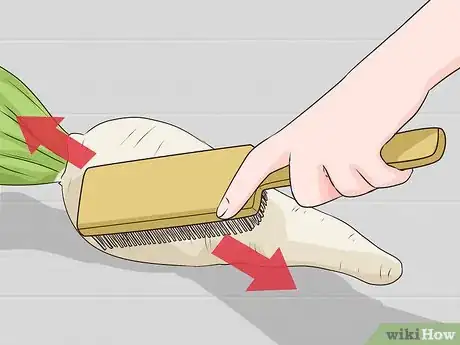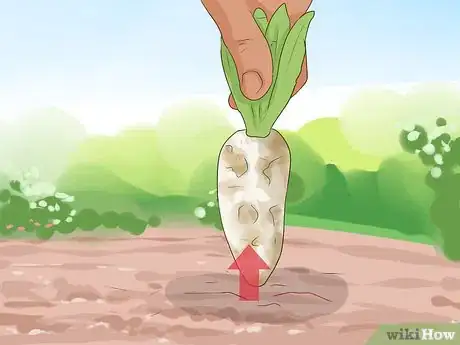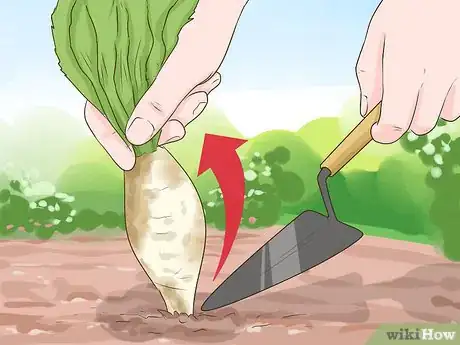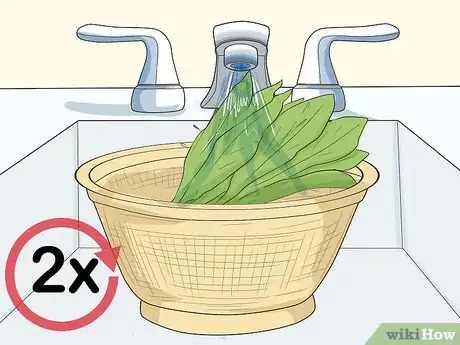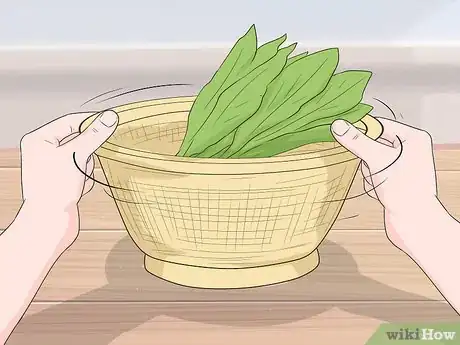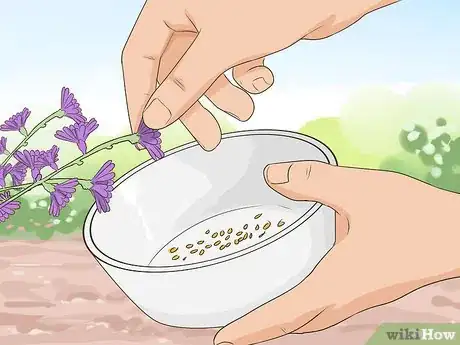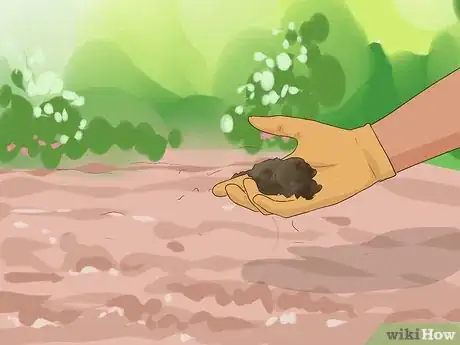This article was co-authored by wikiHow Staff. Our trained team of editors and researchers validate articles for accuracy and comprehensiveness. wikiHow's Content Management Team carefully monitors the work from our editorial staff to ensure that each article is backed by trusted research and meets our high quality standards.
There are 13 references cited in this article, which can be found at the bottom of the page.
wikiHow marks an article as reader-approved once it receives enough positive feedback. In this case, 92% of readers who voted found the article helpful, earning it our reader-approved status.
This article has been viewed 26,838 times.
Learn more...
You can harvest chicory for its leaves, roots, or seeds. Roots can be harvested from fall through early spring. Although you can harvest chicory leaves at any time during the growing season, they are less bitter in early springtime. Summertime is ideal for blanching chicory or collecting seeds. If you don’t grow your own chicory, you can find it growing wild, for example in fields or alongside rural roads.
Steps
Harvesting Roots
-
1Harvest roots from fall through spring. For the best root yield, plant chicory after the last day in March, and before mid-May. Collect the roots between September 1st and November 15th.[1]
-
2Grab the whole plant and pull slowly upwards. Use a hand trowel gently, as needed, to coax the root out of the ground, without nicking or bruising it.[2] The roots may be as deep as two feet (61 cm) in the ground.[3]
- Roots have crowns five to seven inches (13 to 18 cm) in diameter, and tapered taproots. The usable portion of each root is about nine to ten inches (23 to 25 cm).[4]
- If you don’t want the tops of the plants, they can be added to a compost pile.
Advertisement -
3Store the roots. Clip the tops off at two inches (five centimeters) above the roots. Store them in a humid location at 35 to 40 degrees Fahrenheit (2 to 4 degrees Celsius) for up to three months.
-
4Clean the roots before use. Scrub the roots with a plastic-bristled brush. Chop them into pieces on a cutting board with a sharp, heavy knife. You can also grind them with a strong grinder. Then use them for roasting and/or brewing.[5]
-
5Harvest roots in autumn if you want to “force” them. After the first frost, dig out roots that have a top diameter of at least 1.5-2 inches (3.8 to 5 cm). Dig them up carefully so that you don’t bruise them, which may lead to rot. Leave the leaves intact.[6] Place the roots side by side in a garden, covered with straw, or in boxes of sand in a cool, dark, frost-free place until needed.[7]
- ”Forcing” vegetables is when you move them to an artificial growing environment, such as a greenhouse, to produce a harvest outside of the normal growing season.
- Chicory roots should never be frozen, since freezing temperatures change the chemical makeup of the roots.
Harvesting Leaves
-
1Trim tender leaves in the springtime. Look for leaves that are six to eight inches (fifteen to twenty centimeters) long.[8] Chicory leaves are edible throughout the growing season, but become more bitter after early spring. However, you can boil them to reduce bitterness.[9]
- Leaves are ready for harvesting about 60 to 70 days after planting. The Red Rib variety, however, can be harvested for “baby leaf” in 35 days.
-
2Collect the whole plant, or the top only. Use hand clippers to cut the top of the plant off at ground level. Plants with the tops broken off and the root left in the ground will either regrow or add nutrients to the soil.[10]
- To keep the whole plant, grasp it and pull slowly upwards. Use a hand trowel to gently coax the root out of the ground without nicking or bruising them. Cut them at two inches (five centimeters) above the roots, and keep or compost the roots.
-
3Wash the leaves twice. Rinse the leaves well over a sieve under running water. Pour the leaves over paper towels or a clean work surface. Sort through them to discard any grass or dead leaves. Rinse the leaves again.[11]
-
4Drain the leaves. Jiggle the sieve lightly over the sink to shake off drain excess water. Place the sieve over a container or paper towels and allow the leaves to drain.[12]
-
5
-
6Blanch chicory in the summertime, if desired. When a chicory patch has blossom stalks, run it over with a lawnmower set very low. Wait until the leaves return, then cover the area with black plastic, weighed down on the edges. Lift the plastic in about two weeks to harvest a crop of blanched leaves.[15]
- For example, you may want to cover a space four feet (1.2 m) by six feet (1.8 m). You can use large rocks or pieces of pipe to hold down the edges of the plastic.
- Witloof chicory, or French endive, is often blanched for use as a delicacy in salads.[16]
Collecting Seeds
-
1Collect seeds from vigorous plants in summertime. Ideally, choose plants whose leaves have grown freely without trimming. Choose a warm, dry morning when dew is no longer present. Seed collection from chicory is typically done in July.[17]
- Wear gardening gloves and watch out for small bees, which enjoy chicory flowers.[18]
-
2Dry the plants. You can dry chicory as you would herbs. To air dry plants, tie them near the ends of the stems in small bunches. Wrap them loosely in muslin or paper bags that will collect any fallen seeds. Place them in a well-ventilated location, that is not in direct sunlight, for seven to ten days.
- Alternately, you can dry the plants on a rack in an airing cupboard or warming drawer, or use an oven or microwave to dry them.
- If you live in a humid location, try using a small commercial dehydrator to prevent mold.
-
3Separate the seeds from the dried plants. Find seeds in small clusters between bunches of leaves. Use a tiny spoon or round tweezers to carefully scoop underneath the seeds to extract them. Alternately, a faster method is to either crush the pods in a cloth bag, or plant the entire pod.[19]
- Place seedpods in a cloth bag, and smash the bag with a wooden mallet. Screen and winnow them to remove unneeded debris.
- If you plant the entire pods without separating the seeds, multiple seedlings will grow close together and will need thinning.
Finding Chicory
-
1Wear protective clothing. Make sure to put on gardening gloves. If you’re searching in an area where ticks may be a concern – such as a field – wear socks, long pants and a hat. You may also want to put on bug repellant.
-
2Search in sunny locations with compacted, well-drained soil. Chicory enjoys cool and moist conditions with soil that has a pH of 5.8 to 6.5.[20] Some places chicory may be found are fields, vacant city lots, gardens, disturbed ground, and alongside rural roads.[21]
- Make sure to be alert for traffic if you’re collecting wildflowers alongside a roadway. Don’t collect plants from private property or lots with posted “No Trespassing” signs. You can check with your locality – for example, a city hall – if you’re unsure whether or not you’re permitted to collect plants from vacant land.
-
3Confirm the plant is chicory. Chicory has ragged petals that are usually a blue lavender color, although they can sometimes appear white or pink. Mature buds are about an inch (2.5 cm) in diameter. The plant’s branched stem joints are about three inches (eight centimeters), and the stalk is tall. Leaves are narrow and resemble dandelion leaves.[22]
- Chicory comes in many varieties. If you’re unsure if a plant is chicory, consult with at least two field guides and/or online plant databases.
Community Q&A
-
QuestionWhat is the best time and temperature to roast wild chicory roots?
 NinoxTop AnswererThe ideal temperature to roast chicory is 150°C (300°F). The time taken by this can vary a bit depending on the humidity of the roots, but usually it takes roughly 10 minutes.
NinoxTop AnswererThe ideal temperature to roast chicory is 150°C (300°F). The time taken by this can vary a bit depending on the humidity of the roots, but usually it takes roughly 10 minutes.
References
- ↑ https://dl.sciencesocieties.org/publications/cs/abstracts/44/3/748
- ↑ http://tcpermaculture.com/site/2013/08/13/permaculture-project-harvesting-and-using-wild-chicory/
- ↑ https://books.google.com/books?id=lZqn2gaFlW0C&lpg=PP1&pg=PA10#v=onepage&q&f=false
- ↑ https://www.uaex.edu/publications/PDF/FSA-6081.pdf
- ↑ http://tcpermaculture.com/site/2013/08/13/permaculture-project-harvesting-and-using-wild-chicory/
- ↑ https://www.veseys.com/us/en/learn/guide/veginfo/greens/endivebelgian
- ↑ https://www.growveg.com/guides/how-to-force-chicory-for-perfect-chicons/
- ↑ https://www.uaex.edu/publications/PDF/FSA-6081.pdf
- ↑ http://www.motherearthnews.com/homesteading-and-livestock/foraging-food-catnip-chicory-mint-zmaz70sozgoe?pageid=2#PageContent2
- ↑ http://tcpermaculture.com/site/2013/08/13/permaculture-project-harvesting-and-using-wild-chicory/
- ↑ http://www.motherearthnews.com/homesteading-and-livestock/foraging-food-catnip-chicory-mint-zmaz70sozgoe
- ↑ http://www.motherearthnews.com/homesteading-and-livestock/foraging-food-catnip-chicory-mint-zmaz70sozgoe
- ↑ http://www.stilltasty.com/Fooditems/index/16808
- ↑ http://aggie-horticulture.tamu.edu/plantanswers/vegetables/endive.html
- ↑ http://www.motherearthnews.com/homesteading-and-livestock/foraging-food-catnip-chicory-mint-zmaz70sozgoe
- ↑ https://www.uaex.edu/publications/PDF/FSA-6081.pdf
- ↑ http://www.botanical-online.com/food/chicory_cultivation.html
- ↑ https://www.youtube.com/watch?v=E5mhDKgmVg4&feature=youtu.be&t=17
- ↑ https://www.youtube.com/watch?v=E5mhDKgmVg4&feature=youtu.be&t=101
- ↑ https://www.uaex.edu/publications/PDF/FSA-6081.pdf
- ↑ http://www.motherearthnews.com/homesteading-and-livestock/foraging-food-catnip-chicory-mint-zmaz70sozgoe
- ↑ http://www.motherearthnews.com/homesteading-and-livestock/foraging-food-catnip-chicory-mint-zmaz70sozgoe
- ↑ http://tcpermaculture.com/site/2013/08/13/permaculture-project-harvesting-and-using-wild-chicory/



